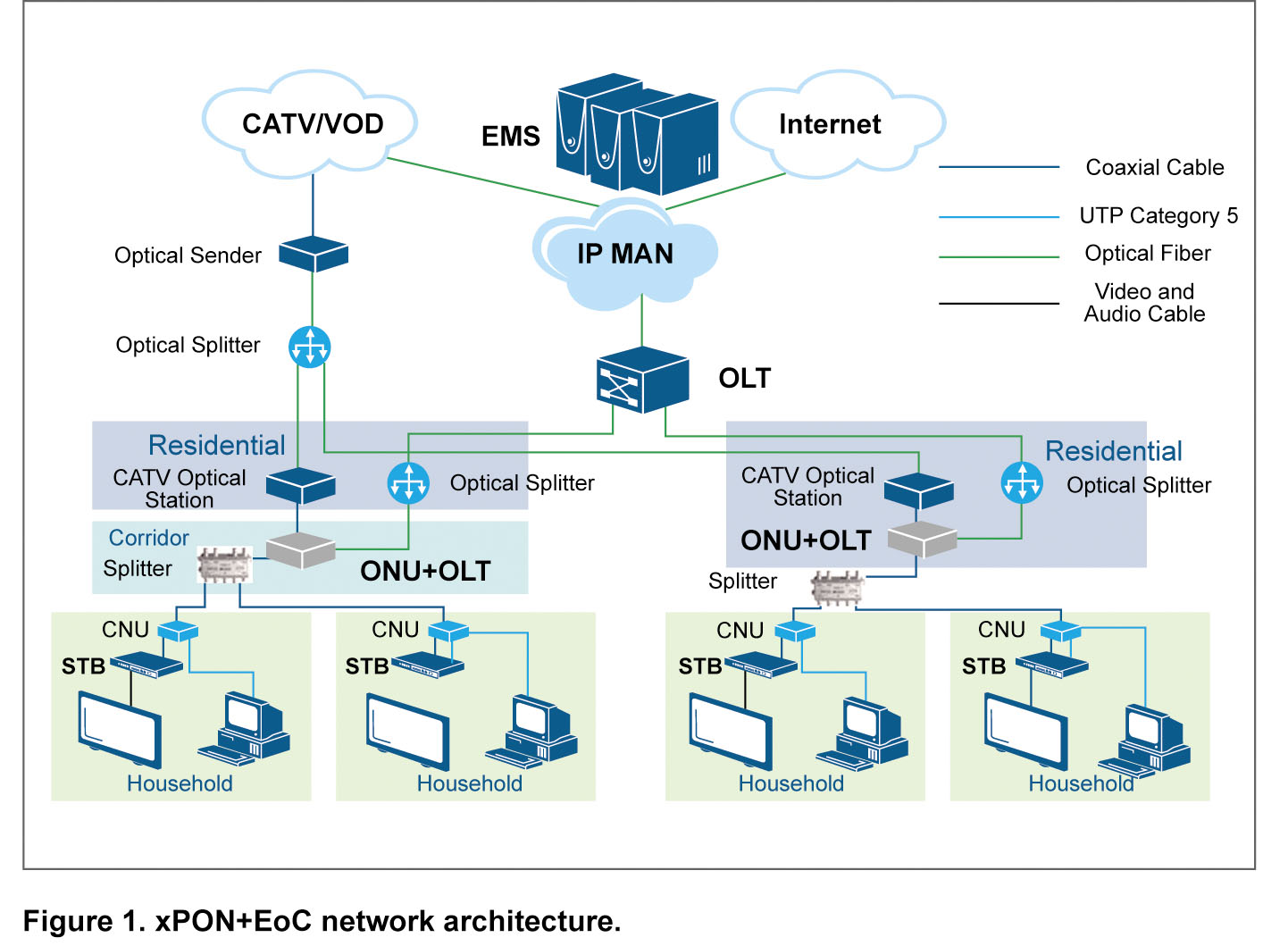Driving Rapid Growth of Tri-Network Convergence with xPON+EoC Solution
Because telecom, radio and TV, and Internet networks exist separately in China, in January 2010, the State Council passed a general proposal for tri-network convergence. Tri-network convergence is a broad concept which does not imply the physical convergence of telecom, Cable TV (CATV), and Internet networks, but rather the convergence of high-level service applications. In technical terms, the three networks must adopt universal IP protocols and be interoperable at the network layer.
To provide converged multimedia voice, data, and image services, network operators are attempting to undergo technical transformation as they compete and cooperate with each other. Triple Screen Delivery—delivery of multimedia content to mobile phone, PC, satellite or digital television—is the simplest application of tri-network convergence. People can make phone calls, watch videos, or access high-speed Internet via mobile phone, TV, or PC.
Service-Driven Growth
VoIP is a basic service requirement of tri-network convergence, and a large number of radio and TV subscribers greatly increase VoIP revenue. IPTV is a video service that will also grow rapidly after tri-network convergence because all users can enjoy it. With the rapid development of 3G wireless communication technologies, mobile TV services have been gradually accepted. IPTV based on tri-network convergence has become the focus of attention in the mobile video field.
Apart from broadcast TV, multicast Video On Demand (VOD) is watched by many people. The large number of mobile users with VOD is a potential source of profit for operators. In their daily lives, people seek information, entertainment, and education through their mobile phones, and hope to enjoy high definition video on the home TV screen. These services improve user loyalty and drive the growth of tri-network convergence.
World’s First Carrier-Class EoC Equipment
ZTE places great importance on tri-network convergence, and has invested heavily in the xPON+EoC solution. Early in 2008, the company launched its Ethernet over Coax (EoC) products in compliance with ITU G.9954. In 2009, research began into EoC based on IEEE P1901 standards, and this passed the xPON+EoC test conducted by China Mobile. In 2010, ZTE developed the industry’s first carrier-class EoC equipment. ZTE, China’s largest xPON equipment vendor, is sparing no effort to help operators build an integrated, carrier-class xPON+EoC solution that is operable, manageable, and profitable.
xPON+EoC Solution
CATV operators own video brands, and have largest base of CATV users (including more than 160 million in China). Telecom operators have abundant Internet resources, mature service operation and management platforms, and well-established brands in the telecom sector. Telecom and CATV operators are therefore in a win-win situation; resources can be shared and the advantages of each can be complementary in the joint development of the family broadband market.
With the trend towards optical access, Hybrid Fiber-Coax (HFC) networks bring fiber even closer to end users and each optical node covers fewer users. CATV broadband access networks are restructured on existing HFC network structures. As illustrated in Figure 1, an Optical Line Terminal (OLT) is placed in the data center. Coax Bandwidth Access Terminals (CBATs)—which integrate Optical Network Unit (ONU) and Cable Line Terminal (CLT) functions (ONU+CLT)—are placed in residential CATV stations or corridors, and Coax Network Units (CNUs) are placed in homes as modems for data decomposition and combination. Deployment of xPON+EoC is divided into service introduction stage and service maturity stage.

Service introduction stage
In the service introduction stage, operators are concerned about lowering construction costs and rapid service provision. With these in mind, ZTE provides the most cost-efficient solution in the initial stage of deployment because it does not radically alter the original network.
OLT can be deployed at the data center, and CBAT (or ONU+CLT) in residential CATV stations. One ONU is connected to one or more CLTs via a UTP Category 5 cable (within 100 meters). The usual distance between CBAT and end users is about one kilometer. CNUs can be placed on users’ desks, so that changes to the network are minimized. Low penetration in the initial stage of service fulfillment means that equipment capacity need not exceed 64 lines. To attract more users, a wide-area coverage mode is adopted in the network.
The above solution has the advantages of low construction cost, fast service deployment, and minimal change to the original network. VoIP services are offered, and users are given 5-10MB bandwidth capacity. It also provides Internet access (1-4MB bandwidth), and supports digital TV.
Service maturity stage
As the network develops, EoC access is gradually accepted by users, and service demands increase rapidly within a short period of time. It therefore becomes necessary to change the original network. The number of users at each CBAT must be decreased because in the maturity stage, the bandwidth allocated to each user increases significantly from 1-4MB to 10-30MB. Since the output bandwidth of CBAT is fixed, to increase the bandwidth for each user, the number of users is reduced from 64 to 10-40. The distance between CBAT and end users is about 300 meters. Because of the higher penetration rate at this stage, higher bandwidth services such as broadband Internet access and high definition digital TV (10-30MB) are offered. Operators can restrict bandwidth according to the user’s service subscriptions.
Since xPON+EoC makes few changes to the HFC network, CATV operators can effectively reduce CAPEX and OPEX. This solution is in line with the IP development trend and is applicable to tri-network convergence in China.
ZTE―the largest vendor of xPON equipment worldwide―has launched a range of integrated EoC equipment for HFC network reconstruction. This equipment has been highly recognized in the industry for its interoperability with xPON and unified network management. It has been widely applied by domestic and international CATV operators including Thailand True, China Telecom, China Mobile, China Unicom, and Hanzhou China Digital TV.